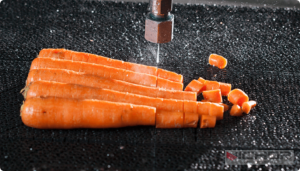
7 Insights into Abrasive Water Jet Micro Machining: Principles, Applications, and Challenges
In the ever-evolving world of precision manufacturing, the demand for technologies capable of machining intricate features into a vast array of materials without inducing thermal damage is higher than ever. Among the frontrunners in this field is Abrasive Water Jet Micro Machining, a miniaturized and highly refined version of conventional abrasive water jet cutting. This process has carved out a critical niche, offering a unique combination of versatility, precision, and cold-cutting capability. This article delves deep into the world of micro-AWJ, exploring its core principles, advantages, applications, and the common challenges engineers face when implementing this sophisticated technology.
What is Abrasive Water Jet Micro Machining? The Core Principle
Abrasive Water Jet Micro Machining is a non-traditional, mechanical-based machining process that utilizes a high-velocity, ultra-fine stream of water mixed with microscopic abrasive particles to erode material from a workpiece. Think of it as an incredibly precise and scaled-down version of its larger counterpart.
The fundamental process involves several key steps:
Pressurization: A high-pressure intensifier pump multiplies water pressure to extreme levels, typically ranging from 40,000 to 90,000 psi (275 to 620 MPa).
Jet Formation: This ultra-high-pressure water is then forced through a miniature gemstone (often diamond or sapphire) orifice, creating a coherent, supersonic water jet.
Abrasive Introduction: The pure water jet enters a mixing chamber, where it creates a vacuum that draws in a precisely controlled flow of fine abrasive grit (e.g., garnet, aluminum oxide). The grit particles are typically in the range of 10 to 50 micrometers, much smaller than those used in macro-AWJ.
Focusing: The mixture of water and abrasive is then focused through a narrow, elongated nozzle (called a focusing tube or mixing tube), which accelerates the abrasive particles.
Machining: This resulting abrasive slurry jet is directed at the workpiece with high precision. The kinetic energy of the abrasive particles is responsible for the micro-machining erosion process, removing tiny amounts of material to create fine features, micro-holes, and complex contours.
Key Advantages of Using a Micro Abrasive Water Jet
Why choose Abrasive Water Jet Micro Machining over other micro-fabrication techniques like lasers or EDM? The benefits are significant and distinct:
No Heat-Affected Zone (HAZ): This is arguably its greatest advantage. As a cold-cutting process, it generates negligible heat, preventing thermal distortion, material metamorphosis, hardening, or micro-cracking in the workpiece. This is crucial for heat-sensitive materials like polymers, composites, and certain metals.
Omni-Material Capability: Micro-AWJ can cut virtually any material, from soft, flexible substances like rubber and foam to super-hard ceramics, glass, composites, titanium, and advanced alloys. Its versatility is unmatched by many other single-process technologies.
High Precision and Minimal Kerf: The micro-scale setup allows for extremely narrow kerf widths (the width of the cut), often as small as 0.1 mm (100 µm) and even smaller with advanced systems. This enables the production of very fine details and features.
Mechanical Stress-Free Machining: Unlike traditional milling or drilling, the tool (the water jet) exerts no lateral mechanical force on the part. This allows for the machining of fragile, thin, or pre-stressed materials without causing deformation or breakage.
Environmentally Friendly: The process produces no hazardous fumes or gases. The used abrasive and removed material can often be collected and separated, making it a cleaner alternative compared to many chemical-based processes.
Primary Applications Across Industries
The unique capabilities of Abrasive Water Jet Micro Machining have led to its adoption in a wide range of high-tech industries:
Medical Device Manufacturing: Used for machining intricate components from biocompatible materials like titanium and stainless steel for implants, cutting precise features in catheters, and creating micro-components for surgical tools.
Electronics and Semiconductors: Ideal for dicing and singulating fragile silicon wafers, ceramics, and composite substrates without creating thermal damage that could ruin electronic components.
Aerospace and Defense: Employed for machining intricate cooling holes in turbine blades, lightweighting components from advanced composites and titanium alloys, and producing delicate parts for guidance systems.
Optics and Photonics: Used for precision cutting of glass, quartz, and optical ceramics for lenses, sensors, and fiber optic components where edge quality is critical and heat must be avoided.
5 Common Challenges in Abrasive Water Jet Micro Machining
Despite its many advantages, achieving optimal results with Abrasive Water Jet Micro Machining requires careful attention to several inherent challenges:
Nozzle Wear and Maintenance: The mixing tube is subject to intense abrasive wear, leading to gradual enlargement and change in its inner diameter. This directly affects kerf width, taper, and cutting accuracy. Frequent inspection and replacement of the nozzle and mixing tube are necessary to maintain consistency, contributing to operational costs.
Managing Taper and Streak Formation: A inherent characteristic of the water jet is that the jet stream can diverge slightly as it travels, resulting in a cut that is not perfectly perpendicular—wider at the top and narrower at the bottom (positive taper) or vice-versa (negative taper). In micro-machining, even a few microns of taper can be critical. Additionally, “streaks” or curved lines can appear on the cut surface due to jet instability.
Achieving High Surface Finish: While the process avoids thermal damage, the mechanical erosion can leave a matte, textured surface finish. For applications requiring a mirror-like finish, Abrasive Water Jet Micro Machining often cannot be used as a final finishing process and must be followed by a secondary polishing or honing operation.
Precise Abrasive Feed Rate Control: In micro-machining, the consistency and control of the abrasive flow rate are paramount. Any fluctuation can lead to variations in cutting speed, kerf width, and edge quality. Ensuring a perfectly consistent, clog-free flow of ultra-fine abrasives is a technical challenge.
Initial Capital Investment: The high-pressure pumps, precision motion systems, and filtration units required for a micro-AWJ system represent a significant capital investment compared to more traditional bench-top micro-machining equipment.
The Critical Role of Parameters and Control
Success in Abrasive Water Jet Micro Machining is heavily dependent on the meticulous optimization and control of a multitude of parameters. These include:
Water Pressure: Higher pressures generally allow for faster cutting speeds and the ability to machine harder materials.
Abrasive Type, Size, and Flow Rate: The choice of abrasive (garnet, olivine, aluminum oxide) and its granulometry directly influences cutting speed, kerf width, and surface roughness.
Standoff Distance: The distance between the nozzle and the workpiece affects jet cohesion and taper.
Traverse Speed: The speed at which the jet moves across the material must be optimized to balance productivity with edge quality and accuracy.
Orifice and Mixing Tube Dimensions: The sizes and condition of these components are the most critical factors in defining the jet’s characteristics.
Modern CNC-controlled systems allow for precise manipulation of these variables, including the ability to make dynamic adjustments to pressure and speed during a cut to further enhance quality, particularly at the start and end of a path.
The future of Abrasive Water Jet Micro Machining is focused on overcoming its current limitations and expanding its capabilities. Key areas of development include:
Advanced Nozzle Designs: Research into more wear-resistant materials and innovative nozzle geometries aims to extend component life and improve jet coherence.
Intelligent Process Monitoring: Integrating real-time sensors and machine vision systems to monitor jet quality, detect nozzle wear, and automatically compensate process parameters to maintain consistent quality without manual intervention.
Hybrid Processes: Combining micro-AWJ with other energy sources (e.g., laser guidance) is being explored to further improve precision, reduce taper, and enhance surface finish in a single setup.
In conclusion, Abrasive Water Jet Micro Machining stands as a powerful and uniquely versatile technology in the micro-manufacturing landscape. Its ability to cold-cut virtually any material with high precision makes it an indispensable tool for industries where thermal damage is not an option. By understanding and proactively managing its challenges—nozzle wear, taper, and surface finish—manufacturers can fully leverage the potential of this remarkable technology to produce innovative and high-quality micro-components.
continue reading
Related Posts
- 1666 words8.4 min read



